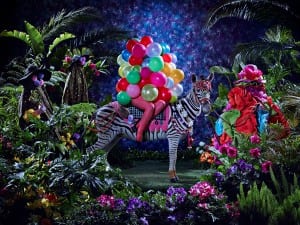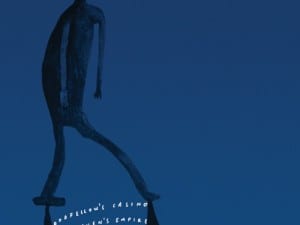Genre divides in music have become increasingly irrelevant. As time goes by the boundaries continue to blur, but why now, what’s changing?
There are few bands in the world madder as a concept than Josephine and the Artizans. For starters, there are 10 of them. They’re led by opera singer Josphine Permaul, and she heads up a line-up of three rappers, a guitarist, a drummer, a bass player and a three-piece string section. Josephine and the Artizans are what happens when the boundaries between genres crumble completely, letting performers from different worlds perform together.
Permaul was never going to stick to just one genre. She trained in classical voice, piano and violin when she was younger, but she was reluctant to stick to just one style of music. “I thought that instead of going down the classical route, I’d go somewhere to study commercial pop music,” she says. “I went to the University of Westminster, and while I was there I found that my voice didn’t fit into any particular genre of pop. So I thought I’d use my voice to combine classical with more rock and pop-oriented stuff.”
It was that combination of rock and pop and classical and opera that resulted in her 10-piece outfit. It’s the most literal expression of how musical genres change, of how fluid they are and how the conventions which define them have started to erode. Managing such an unwieldy group, corralling all these different styles, takes every ounce of chutzpah Permaul has. They’re gearing up to release a new EP, Dies Irae (Day of Wrath) and the fact that they haven’t imploded at this point from sheer stress alone is worth applause.
“You have to work together as a team,” Permaul says. “The rappers, for example, are constantly emailing back and forth, checking lyrics with me, seeing how they work with the song. My string players have a completely different approach from my rhythm section, but when I recruited them, I had quite intense auditions to make sure they were interested in the music.”
Breaking down the expectations of each genre isn’t easy, she says. “It’s very hard to find classical string players who can improvise and write complementary parts to the rest of the song, rather than something very complicated and melodic. And classical musicians can be, at times, quite timid, and sometimes they are rather uncomfortable with improvisation.”
Blending discrete genres isn’t an entirely new phenomenon. Hip-hop came about from a heady mix of blues, jazz, reggae and soul. Rock and jazz techniques mixed to become prog rock. However, in the past 10 years, this kind of melding of genres has exploded. A whole slew of musicians have been rewriting the rules, appropriating whatever they see fit to create their music. Vampire Weekend mix afrobeat and indie rock. The Easy Star All-Stars often combine dub reggae with rock, resulting in interpretations of Pink Floyd and Radiohead. Tune-Yards and Gang Gang Dance seem to draw from a dozen genres all at once. Collectively, artists like these have sold hundreds of thousands of records and songs, possibly millions. Genre-blending is something music fans are clearly comfortable with. However, the question is still: why? Why, in the past decade, have the walls come tumbling down?
Jared Gudstadt thinks that technology has something to do with it. He’s the CEO and co-founder of Jingle Punks, an American company that specialises in production music. For Gudstadt, it was when music software and equipment became a lot cheaper – a process that began a little over a decade ago. “It’s tinker theory,” Gudstadt says. “When you’re sitting at home and you have a laptop, and an infinite number of creative possibilities, you’re gonna get bored really quickly with doing things that have been done before. There’s an explosion of new genres based on things merging together.”
Jingle Punks are a fascinating example of this. Alongside their roster of composers, they have an in-house string ensemble, The Hipster Orchestra. The group originally came about when Gudstadt was looking for a way to promote his music company in a crowded marketplace. “I started arranging classical interpretations of my favourite bands,” he says. “The Black Keys, The White Stripes, MGMT, Kanye West, Jay-Z. After two or three years of videos, we found it was a great way for people to understand our company, and it was also a great way to give other people access to these songs, by doing tribute records. The bass is the cello, the lead is the Chair A violin and the piano comes from over there. I was happy to change to this set-up. Some of the early adaptations we did, like Matt and Kim or Nirvana, they still maintain a rock feel, but were delivered in a style that was closer to classical music. Furthermore, I needed to understand the genre better, and I wanted to give people a way to appreciate classical styles better.”
However, The Hipster Orchestra mushroomed. It stopped being a promotional unit within a company, and became its own thing. Today, it’s arguably more well known than the corporate entity that gave birth to it (although there’s no evidence that the two have anything but a harmonious relationship). “The Hipster Orchestra started as a way for me to market Jingle Punks, and it became its own thing,” says Gudstadt. “We [started] getting offers to play stadiums, major festivals, and I’m struggling to figure out how to balance that with being CEO of a company with 70 people in it.”
For starters, the orchestra itself has begun to blend genres. They’re shortly to travel to South Africa, where they’ll back up hip-hop artist Nas. (Gudstadt: “I was drunk last year in Cannes, and I went up to Nas and told him that we had this orchestra and wanted to do Illmatic, and he said, ‘cool, you should meet my manager’…”). They’ve also become known for an interpretation of Nirvana’s In Utero, which they did for the album’s 20th anniversary.
It’s this latter project which shows just how much some genres have in common – a surprising fact, given how different punk rock and classical would appear to be. Gudstadt says that a lot of Nirvana’s music is “extremely European” in terms of its chords. He calls it a lot more complex than the music of other punk rockers like the Ramones, Pearl Jam or The Clash, and says that some of the stuff Nirvana lead singer Kurt Cobain wrote was highly complex. The songs, once The Hipster Orchestra got hold of them, were extraordinary. “Some of the stuff sounded like Wagner,” says Gudstadt. “We basically had two weeks to come up with the arrangements and get in studio. We recorded it in one day and shot all the music videos at the same time. It was awesome. I was playing ukulele and mandolin, and it was fun to play aggressive ukulele over Smells Like Teen Spirit and Lithium.”
Genre-bending is clearly working, and it’s obviously being accepted by a huge section of the listening public. It’s tempting to view this as a breakaway from the corporate side of the music industry – the folks in suits who demand that music be labelled and pigeonholed, put in little boxes so it can sell to the right demographic. But that’s a misunderstanding of where genre names come from. They are, by and large, invented by the artists themselves.
Tommy Dorsey, according to a 2011 Guardian newspaper article, first applied the term “gospel” to music. The name “hip-hop” meanwhile originally comes from a rhyme by DJ LoveBug Starski. This isn’t universal – you can thank big record labels for the proliferation of such weird labels as “EDM” and “big beat.”
But the point is this: artists have always redefined and tweaked their chosen genres, and simply because it’s become more noticeable in recent years doesn’t mean this crossing of stylistic boundaries shouldn’t be welcomed.
What it does require from artists is a willingness to experiment – and a refusal to give up when the going gets tough. “In our track Carpe Diem,” says Permaul, “I picked the string phrase from Vivaldi’s summer season, and some people thought it wouldn’t work, that it wouldn’t go anywhere. We had to try really hard to make a success of the idea, and I kept saying, ‘let’s give it one more go’. But we haven’t tried a piece we’ve given up on yet. I’ve been very stubborn!”
For further information, visit www.josephinenadtheartizans.com and www.hipsterorchestra.com.
Rob Boffard





